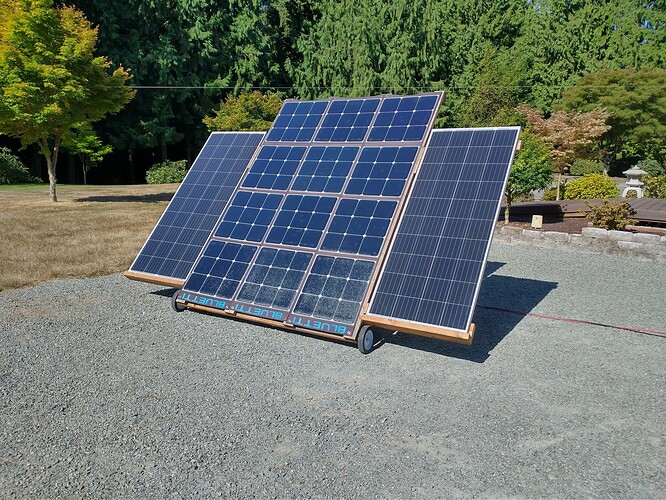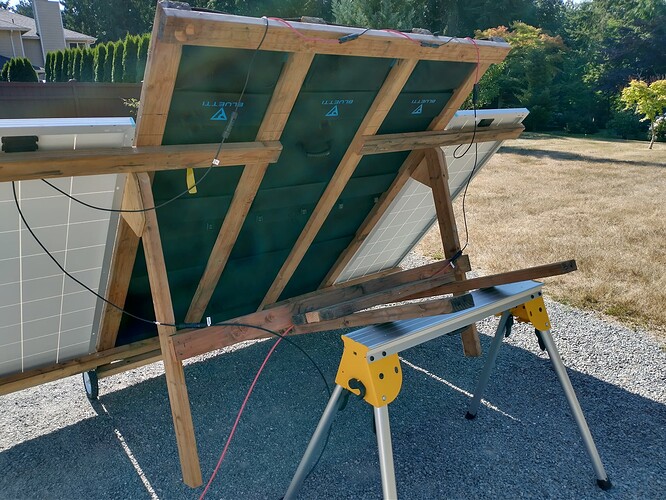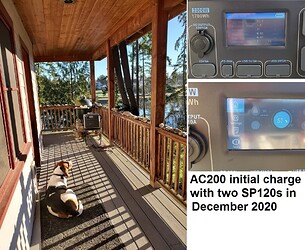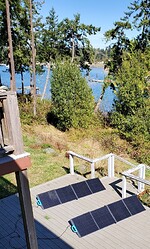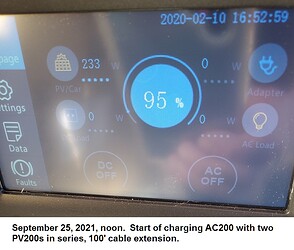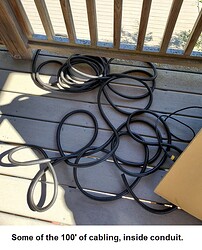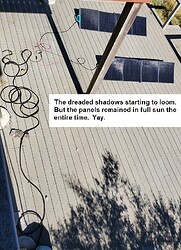Tested with a Bluetti EB55 which has a 200 watt max solar input. Solar conditions were pretty good with no clouds but had a slight marine haze. Using my solar rack all the panels were aimed at the sun exactly the same.
1 panel - Bluetti 134 watts, Renogy 153 watts.
2 panels in parallel - Bluetti 161 watts, Renogy 174 watts.
The panels had been out in the sun for several hours before testing so they should have been stabilized temperature wise. With an air temp of around 70 degrees the face of Bluetti panel was at 136 degrees and the Renogy was at 112 degrees. I’m guessing the Bluetti’s run hotter due to the black fabric holding them together on the back which might reduce cooling.
A question for the experts, would 24 degrees of temperature difference make that big of a difference in wattage?
3 Likes
@eric102 im not an expert by any means man but yea I have heard that temperature does play a big role in output power… now 24 degrees having that big of a difference?? I’m not sure.
Maybe try this same test again but try bringing out the 2nd panel/set out later, after the 1st panels have heated up and see what your results are??
This is a fantastic test and an incredible setup you’ve got going man! I love it and am really eager myself to see what results you come up with!!
Thanks for sharing bud!
2 Likes
I think your limiting factor here is with the EB55 used as a receiver. The incoming wattage of the EB55 is limited to approx. 160 watts due to design and voltage / amperage limits. If you were connecting the panels in series and using an AC200 series I think you would see a big improvement in wattage.
2 Likes
Yeah I was going to try that with my EB150 today since it can do both a single panel and 2 panels in series. Will also test 2 panels on the AC200P but the displayed wattage on it fluctuates quite a bit so its hard to get a good reading.
Good idea, will try cool vs hot on both sets of panels just for fun.
1 Like
Tested the panels with my EB150 this morning about 1 1/2 hours before solar noon, conditions were a little hazier than yesterday but not bad. Air temp about the same in the low 70’s.
First test was a single panel just out of the garage to see what the output was before it heated up.
Renogy 1 - 172 watts, temperature of the glass face was 78 degrees.
Renogy 2 - 168 watts, same temp.
Bluetti 1 - 161 watts, same temp.
Bluetti 2 - 162 watts, same temp.
Bluetti 3 - 158 watts, same temp.
Looks like the Renogy outperforms the Bluetti by about 10 watts per panel when the glass temps are the same.
Second test was a single panel about a 1/2 hour later after the panel temps had stabilized (checked the temps an hour later and they hadn’t changed much).
Renogy - 154 watts with a face temp of 115 degrees.
Bluetti - 140 watts with a face temp of 147 degrees.
The Renogy lost 16 watts to heating and the Bluetti about 20 watts, so the black fabric of the Bluetti probably isn’t a big contributor to performance difference but it can add up with multiple panels.
I also checked with 2 panels in series shortly after the second test and the Renogy’s produced 310 watts while the Bluetti’s pulled 285 watts which is in line with the single panel results.
Combined with with my EB55 single panel tests above it appears that the fixed panel Renogy’s will out perform the portable Bluetti’s by 14 to 19 watts at my location, on this day and at these temps, YMMV 
It was starting to get overcast when I tried 2 panels in series on my AC200P but the results were similar although its hard to get a good reading on mine since the watts display jumps around constantly, often by 20 watts. My best guess averaging was the Renogy’s did 278 watts and the Bluetti’s 260 watts.
Well, I see 40 solar cells on the Renogy vs 36 on the Bluetti. Wouldn’t that make a difference?
1 Like
Renogy has the thermal specs in a downloadable pdf specifications document on their website. Some manufacturers give those specs, some don’t. Bluetti doesn’t publish them. 25 degrees Celsius is the usual base temperature.
I read somewhere, can’t remember where, that if you can’t find the actual spec for temperature, then 3% power change per 10 degrees Celsius is a reasonable approximation.
Solar Professor has some videos on YouTube that are good. He has one on the IV curve for panels and I recall that he talks about temperature affects also.
I have found that fixed cells perform slightly better with regard to wattage. Not sure it is exactly an apples to apples test with two panel brands and cell types but the main advantage is portability for the soft panels. Fixed panels usually have an advantage with cost, weather and age resistance.
I’m a solar rookie so no idea if the number of cells has anything to do with it, both are rated at 200 watts. They do have different volts/amps but end up the same. Renogy - 22.6v x 8.85A. Bluetti - 20v x 10A.
1 Like
I agree, love my portables, way easier to store and transport.
Thanks, great info! Will check it out.
Bluetti has new panels, PV200. I believe they will be coming out with a larger one as well, perhaps 350W. This is what they said about the difference between the SP200 and PV200. I recently ordered the PV200 and already have SP200, so I will be interested to see if the difference is marked.
4 Likes
Looking forward to your report, especially the shading performance.
1 Like
Definitely looking forward to more testing. The PV200 are bundled with the new AC300 coming out.
I did do several tests with the PV200 and pitting PV200 against SP200, but my conditions are likely quite different from others.
One test was to prove you could charge an AC200 using just two panels, owing to an argument on FB, lol. I had previously shown how I charged the AC200 when I first got it, with two SP120s hung vertically from my deck, in the middle of winter in the PNW. It was said that because I had the AC200 out on the deck (shaded) with no solar extension cable, that my case was the exception, i.e. cold weather and no extension cable.
So I got out a 100’ 12AWG solar extension cable meant for another location and connected two PV200s, set out on a lower deck, to the AC200. It was already at 95% SOC, so I believe it was not ideal, as all my sogens tend to ramp down on solar charging as they get close to full. I got 233W from two panels in series. Not great, but again, extra long cable and sogen nearly fully charged. This was a normal late summer day (well, Sept 24th, so I guess early fall) and the weather was 70°, and definitely a lot hotter on the deck.
I probably could have gotten more watts by adjusting the angle. I think in hindsight I had them angled more for summer than fall. One thing I love about the PV200s is that the kickstands are very adjustable.
So here are photo results of that test, and I’ll post another where I pitted the PV200 against an SP200. I wish I had the PV200 back when we had smoky skies, to test out the capability with diminished solar potential. I am sure it would have performed better than the SP200 under those conditions.
First, showing the AC200 charging with two SP120s in series in December 2020:

Here, charging AC200 with two PV200s in series, 100’ solar extension cable, Sept 24th, 2021, noon, with 95% SOC:
This says Sept 25th, but that was when I edited photos. Oops.
3 Likes
